Seasons Effects of Field Measurement of Near-Ground Wind Characteristics in a Complex Terrain Forested Region
Abstract
1. Introduction
2. Equipment and Data Processing
- Sampling is first performed to obtain a series of data samples divided into subintervals.
- Calculate the mean of a single sample , and determine the magnitude of xi and , If , is recorded as “+”, if , is recorded as “−”.
- The consecutive occurrence of symbols is recorded as a run, that is, “+” or “−” as long as the occurrence of symbols exchange runs are counted separately, and the total number of runs is recorded as R. The total number of runs of “+” is N1, and the total number of runs of “−” is N2, .
- Hypothesis test H0: The sample is a stationary random series.
- R approximately obeys the normal distribution , where and .
3. Results and Discussions
3.1. Mean Wind Speed
3.2. Mean Wind Directions
3.3. Turbulence Intensity
3.3.1. Variation with Wind Speed
3.3.2. Variation with Height
3.3.3. PDF Distribution
3.4. Turbulent Spectrum
3.5. Vertical Spatial Coherence
4. Concluding Remarks
- (1)
- Due to the seasonal variation in the near-ground atmospheric boundary layer in the forested region, the mean wind speed profile exhibits different gradients in different seasons, while the mean wind direction also shows seasonal differences. Although the power-law model can capture the basic shape of mean wind speed profiles in forested regions in different seasons, the definite parameters in the standard cannot fully reflect the vertical distribution of wind speed, while the seasonally fitted parameters have higher applicability for better reproduction of mean wind profiles in forested regions where the roughness varies with season. The mean wind direction ranges from 270° to 300° in autumn and winter, 240° to 300° in spring, but 240° to 300° and 60° to 150° in summer, which indicates that the mean wind direction changes in summer due to temperature and pressure differences and canopy disturbances. It is also pointed out that the influence of season should be given priority for the mean wind direction.
- (2)
- The power-law function can predict the turbulence intensity profile in different seasons in the forested region. However, the fitted parameters differed significantly from season to season, while each turbulence intensity component converged at different values in different seasons at high wind speed conditions. This demonstrates the significant seasonal effects on the power-law function of turbulence intensity in forested regions. Meanwhile, the ratios of the three turbulence intensity components are significantly affected by the seasons, with low ratios in the vertical and longitudinal directions for the cold and canopy-sparse autumn and winter, and low ratios in the lateral and longitudinal directions for the hot and canopy-rich summer. This indicates that the ratio of turbulence intensity components proposed by specifications and standards is not adapted to the forest engineering sites. In addition, three directions’ PDF distributions have different μ and σ parameters in different seasons at different heights, while the log-normal distribution can better characterize the longitudinal and vertical turbulence intensity in each season and the PDF distribution at the lateral 50 m height. However, canopy and branch disturbances affect the lateral turbulence intensity at 20 m and 35 m height, and the log-normal distribution does not characterize the lateral PDF distribution well in each season with a bimodal trend.
- (3)
- The Simiu and Panofsky spectral model no longer applies to turbulent fields in the forested region in all seasons. However, the Von Kármán spectrum still has important applicability for such topographic sites. The longitudinal, lateral, and vertical component spectral models remained constant with increasing height each season but were not similar between the components. The turbulent spectrum differs in various seasons, although they are points at the same height. In addition, the turbulence integration length scale in all three directions increases with height. This paper shows that the turbulent flow spectrum with definite parameters no longer applies in the forested region.
- (4)
- The modified empirical coherence formula can better reflect the vertical spatial coherence in the four seasons in the forested region with appropriate parameters. In the forested region, the lateral coherence in seasons is weaker than the other two coherences, which corresponds to the PDF distribution of the turbulence intensity. Meanwhile, the fitted parameters K and C do not have consistent seasonal regularity in different directions. So, the seasonally fitted parameters fitted by field measurement data are essential for their vertical spatial coherence in engineering applications.
Author Contributions
Funding
Data Availability Statement
Conflicts of Interest
Nomenclature
| CFD | Computational Fluid Dynamics | Ii | turbulence intensity |
| PIV | Particle Image Velocimetry | c, d | fitted parameters in Equation (8) |
| R | the total number of runs | I10 | nominal turbulence intensity at a height of 10 m |
| N1 | the total number of runs of “+” | probability density function | |
| N2 | the total number of runs of “−” | std | standard deviation |
| Z | the test statistic | Ex | expectation value |
| μ | mean value | f | frequency |
| σ | standard deviation | Su,v,w(f, z) | turbulent wind spectrum |
| Ui | wind speed vector data in a Cartesian system | u* | friction wind speed |
| β | wind direction angle | fz | non-dimensional reduced frequency |
| u, v and w | longitudinal, lateral, and vertical fluctuating wind speeds | Lu,v,w | turbulent integral length scale |
| mean wind speed | Cxy | coherence estimates | |
| W | vertical mean wind speed | Pxy | cross-spectral density |
| U | wind speed at the height of Z (m) | Pxx, Pyy | auto-spectral density |
| Uref | reference wind speed | C | decay coefficient |
| Zref | reference height | Δ | separation distance |
| α | surface roughness coefficient | K | fitted parameters in Equation (20) |
References
- Giannaros, T.M.; Melas, D.; Ziomas, I. Performance evaluation of the Weather Research and Forecasting (WRF) model for assessing wind resource in Greece. Renew. Energy 2017, 102, 190–198. [Google Scholar] [CrossRef]
- Hsiao, C.Y.L.; Sheng, N.; Fu, S.Z.; Wei, X.Y. Evaluation of contagious effects of China’s wind power industrial policies. Energy 2022, 238, 121760. [Google Scholar] [CrossRef]
- Pena, A.; Floors, R.; Sathe, A.; Gryning, S.E.; Wagner, R.; Courtney, M.S.; Larsen, X.G.; Hahmann, A.N.; Hasager, C.B. Ten Years of Boundary-Layer and Wind-Power Meteorology at Hovsore, Denmark. Bound. -Layer Meteorol. 2016, 158, 1–26. [Google Scholar] [CrossRef]
- da Silva, A.F.G.; de Andrade, C.R.; Zaparoli, E.L. Wind power generation prediction in a complex site by comparing different numerical tools. J. Wind Eng. Ind. Aerodyn. 2021, 216, 104728. [Google Scholar] [CrossRef]
- Ying, C.; Wenyi, F.; Yibo, W. Study on Seasonal Dynamics of Leaf Area Index in Maoer Mountain. For. Eng. 2016, 32, 1–6. [Google Scholar] [CrossRef]
- Liu, X.G.; Cao, J.L.; Xin, D.B. Wind field numerical simulation in forested regions of complex terrain: A mesoscale study using WRF. J. Wind Eng. Ind. Aerodyn. 2022, 222, 104915. [Google Scholar] [CrossRef]
- Cao, J.L.; Xue, W.H.; Mao, R.; Xin, D.B. Wind power in forested regions: Power law extrapolation vs. lidar observation. J. Wind Eng. Ind. Aerodyn. 2023, 232, 105281. [Google Scholar] [CrossRef]
- Zhou, L.; Li, H.H.; Tse, T.K.T.; He, X.H.; Maceda, G.Y.C.; Zhang, H.F. Sensitivity-aided active control of flow past twin cylinders. Int. J. Mech. Sci. 2023, 242, 108013. [Google Scholar] [CrossRef]
- Wen, J.H.; Zhou, L.; Zhang, H.F. Mode interpretation of blade number effects on wake dynamics of small-scale horizontal axis wind turbine. Energy 2023, 263, 125692. [Google Scholar] [CrossRef]
- Zhang, H.F.; Zhou, L.; Tse, T.K.T. Mode-based energy transfer analysis of flow-induced vibration of two rigidly coupled tandem cylinders. Int. J. Mech. Sci. 2022, 228, 107468. [Google Scholar] [CrossRef]
- Tamura, T.; Okuno, A.; Sugio, Y. LES analysis of turbulent boundary layer over 3D steep hill covered with vegetation. J. Wind Eng. Ind. Aerodyn. 2007, 95, 1463–1475. [Google Scholar] [CrossRef]
- Liu, Z.Q.; Ishihara, T.; He, X.H.; Niu, H.W. LES study on the turbulent flow fields over complex terrain covered by vegetation canopy. J. Wind Eng. Ind. Aerodyn. 2016, 155, 60–73. [Google Scholar] [CrossRef]
- Li, Z.; Yu, S.; Wu, H.; Zhou, L. Numerical simulation of flow field around the tree in strong wind. J. Cent. South Univ. Sci. Technol. 2021, 52, 3970–3980. [Google Scholar]
- Cao, J.X.; Tamura, Y.; Yoshida, A. Wind tunnel study on aerodynamic characteristics of shrubby Specimens of three tree species. Urban For. Urban Green. 2012, 11, 465–476. [Google Scholar] [CrossRef]
- Lee, J.P.; Lee, S.J. PIV analysis on the shelter effect of a bank of real fir trees. J. Wind Eng. Ind. Aerodyn. 2012, 110, 40–49. [Google Scholar] [CrossRef]
- Li, Z.; Li, F.; Chen, B.; He, D. Wind Tunnel Test on Wind Load and Flow Field Characteristics of Trees. Sci. Silvae Sin. 2020, 56, 173–180. [Google Scholar]
- Ma, R.; Wang, J.H.; Qu, J.J.; Liu, H.J. Effectiveness of shelterbelt with a non-uniform density distribution. J. Wind Eng. Ind. Aerodyn. 2010, 98, 767–771. [Google Scholar] [CrossRef]
- de Santana, R.A.S.; Dias, C.Q.; do Vale, R.S.; Tota, J.; Fitzjarrald, D.R. Observing and Modeling the Vertical Wind Profile at Multiple Sites in and above the Amazon Rain Forest Canopy. Adv. Meteorol. 2017, 2017, 5436157. [Google Scholar] [CrossRef]
- Jiang, H.X.; Zhang, H.F.; Xin, D.B.; Zhao, Y.B.; Cao, J.L.; Wu, B.C.; Su, Y.K. Field measurement of wind characteristics and induced tree response during strong storms. J. For. Res. 2022, 33, 1505–1516. [Google Scholar] [CrossRef]
- Xin, D.; Jiang, H.; Zhang, H. Measurement on wind field characteristics and wind-induced dynamic response in broadleaved forest. Acta Aerodyn. Sin. 2022, 40, 110–121. [Google Scholar]
- ASCE/SEI 7–10; Minimum Design Loads for Buildings and Other Structures. American Society of Civil Engineers: Reston, VA, USA, 2010.
- AIJ-RLB-2004; Recommendations for Loads on Building-Wind Loads. Architectural Institute of Japan: Tokyo, Japan, 2004.
- JTG/T 3360-01; Wind-resistant Design Specification for Highway Bridges. Ministry of Communications of the People’s Republic of China: Beijing, China, 2018.
- ESDU82031; Paraboloidal Antennas: Wind Loading. Part 1: Mean Forces and Moments. ESDU International: London, UK, 2012.
- AS/NZS1170.2; Structural Design Actions, Part 2: Wind Actions. Jointly published by SAI Global Limited under license from Standards Australia Limited: Sydney, Australia, 2011.
- Bastos, F.; Caetano, E.; Cunha, A.; Cespedes, X.; Flamand, O. Characterisation of the wind properties in the Grande Ravine viaduct. J. Wind Eng. Ind. Aerodyn. 2018, 173, 112–131. [Google Scholar] [CrossRef]
- Fenerci, A.; Oiseth, O. Strong wind characteristics and dynamic response of a long-span suspension bridge during a storm. J. Wind Eng. Ind. Aerodyn. 2018, 172, 116–138. [Google Scholar] [CrossRef]
- Jing, H.M.; Liao, H.L.; Ma, C.M.; Tao, Q.Y.; Jiang, J.S. Field measurement study of wind characteristics at different measuring positions in a mountainous valley. Exp. Therm. Fluid Sci. 2020, 112, 109991. [Google Scholar] [CrossRef]
- Wang, X.C.; Wang, C.K.; Li, Q.L. Wind Regimes above and below a Temperate Deciduous Forest Canopy in Complex Terrain: Interactions between Slope and Valley Winds. Atmosphere 2015, 6, 60–87. [Google Scholar] [CrossRef]
- Wang, H.; Wu, T.; Tao, T.Y.; Li, A.Q.; Kareem, A. Measurements and analysis of non-stationary wind characteristics at Sutong Bridge in Typhoon Damrey. J. Wind Eng. Ind. Aerodyn. 2016, 151, 100–106. [Google Scholar] [CrossRef]
- Tao, T.Y.; Wang, H.; Wu, T. Comparative Study of the Wind Characteristics of a Strong Wind Event Based on Stationary and Nonstationary Models. J. Struct. Eng. 2017, 143, 04016230. [Google Scholar] [CrossRef]
- Ren, W.M.; Pei, C.; Ma, C.M.; Li, Z.G.; Wang, Q.; Chen, F. Field measurement study of wind characteristics at different measuring positions along a bridge in a mountain valley. J. Wind Eng. Ind. Aerodyn. 2021, 216, 104705. [Google Scholar] [CrossRef]
- Xu, Y.L.; Chen, J. Characterizing nonstationary wind speed using empirical mode decomposition. J. Struct. Eng. 2004, 130, 912–920. [Google Scholar] [CrossRef]
- Chen, J.; Hui, M.C.H.; Xu, Y.L. A comparative study of stationary and non-stationary wind models using field measurements. Bound. -Layer Meteorol. 2007, 122, 105–121. [Google Scholar] [CrossRef]
- Qin, Z.Q.; Xia, D.D.; Dai, L.M.; Zheng, Q.S.; Lin, L. Investigations on Wind Characteristics for Typhoon and Monsoon Wind Speeds Based on Both Stationary and Non-Stationary Models. Atmosphere 2022, 13, 178. [Google Scholar] [CrossRef]
- Liao, H.L.; Jing, H.M.; Ma, C.M.; Tao, Q.Y.; Li, Z.G. Field measurement study on turbulence field by wind tower and Windcube Lidar in mountain valley. J. Wind Eng. Ind. Aerodyn. 2020, 197, 104090. [Google Scholar] [CrossRef]
- Jung, C.; Schindler, D. The role of the power law exponent in wind energy assessment: A global analysis. Int. J. Energy Res. 2021, 45, 8484–8496. [Google Scholar] [CrossRef]
- Shikhovtsev, A.; Kovadlo, P.; Lukin, V.; Nosov, V.; Kiselev, A.; Kolobov, D.; Kopylov, E.; Shikhovtsev, M.; Avdeev, F. Statistics of the Optical Turbulence from the Micrometeorological Measurements at the Baykal Astrophysical Observatory Site. Atmosphere 2019, 10, 661. [Google Scholar] [CrossRef]
- Potekaev, A.; Krasnenko, N.; Shamanaeva, L. Diurnal Dynamics of the Umov Kinetic Energy Density Vector in the Atmospheric Boundary Layer from Minisodar Measurements. Atmosphere 2021, 12, 1347. [Google Scholar] [CrossRef]
- Shikhovtsev, A.Y.; Kovadlo, P.G. Estimation of mean energy characteristics of atmospheric turbulence at various heights from reanalysis data. IOP Conf. Ser.: Earth Environ. Sci. 2018, 211, 012023. [Google Scholar] [CrossRef]
- Lin, L.; Chen, K.; Xia, D.D.; Wang, H.F.; Hu, H.T.; He, F.Q. Analysis on the wind characteristics under typhoon climate at the southeast coast of China. J. Wind Eng. Ind. Aerodyn. 2018, 182, 37–48. [Google Scholar] [CrossRef]
- Kikumoto, H.; Ooka, R.; Sugawara, H.; Lim, J. Observational study of power-law approximation of wind profiles within an urban boundary layer for various wind conditions. J. Wind Eng. Ind. Aerodyn. 2017, 164, 13–21. [Google Scholar] [CrossRef]
- Simiu, E.; Scanlan, R.H. Wind Effects on Structures: Fundamentals and Applications to Design; John Wiley: New York, NY, USA, 1996; Volume 688. [Google Scholar]
- Davenport, A.G. The spectrum of horizontal gustiness near the ground in high winds. Q. J. R. Meteorol. Soc. 1961, 87, 194–211. [Google Scholar] [CrossRef]
- Panofsky, H.A.; McCormick, R.A. The spectrum of vertical velocity near the surface. Q. J. R. Meteorol. Soc. 1960, 86, 495–503. [Google Scholar] [CrossRef]
- Cao, S.; Tamura, Y.; Kikuchi, N.; Saito, M.; Nakayama, I.; Matsuzaki, Y. Wind characteristics of a strong typhoon. J. Wind Eng. Ind. Aerodyn. 2009, 97, 11–21. [Google Scholar] [CrossRef]
- Hui, M.C.H.; Larsen, A.; Xiang, H.F. Wind turbulence characteristics study at the Stonecutters Bridge site: Part II: Wind power spectra, integral length scales and coherences. J. Wind Eng. Ind. Aerodyn. 2009, 97, 48–59. [Google Scholar] [CrossRef]
- Yu, C.J.; Li, Y.L.; Zhang, M.J.; Zhang, Y.; Zhai, G.H. Wind characteristics along a bridge catwalk in a deep-cutting gorge from field measurements. J. Wind Eng. Ind. Aerodyn. 2019, 186, 94–104. [Google Scholar] [CrossRef]
- Peng, Y.B.; Wang, S.F.; Li, J. Field measurement and investigation of spatial coherence for near-surface strong winds in Southeast China. J. Wind Eng. Ind. Aerodyn. 2018, 172, 423–440. [Google Scholar] [CrossRef]
- Mann, J.; Kristensen, L.; Courtney, M. The Great Belt Coherence Experiment. A Study of Atmospheric Turbulence Over Water; Risø National Laboratory: Roskilde, Denmark, 1991. [Google Scholar]
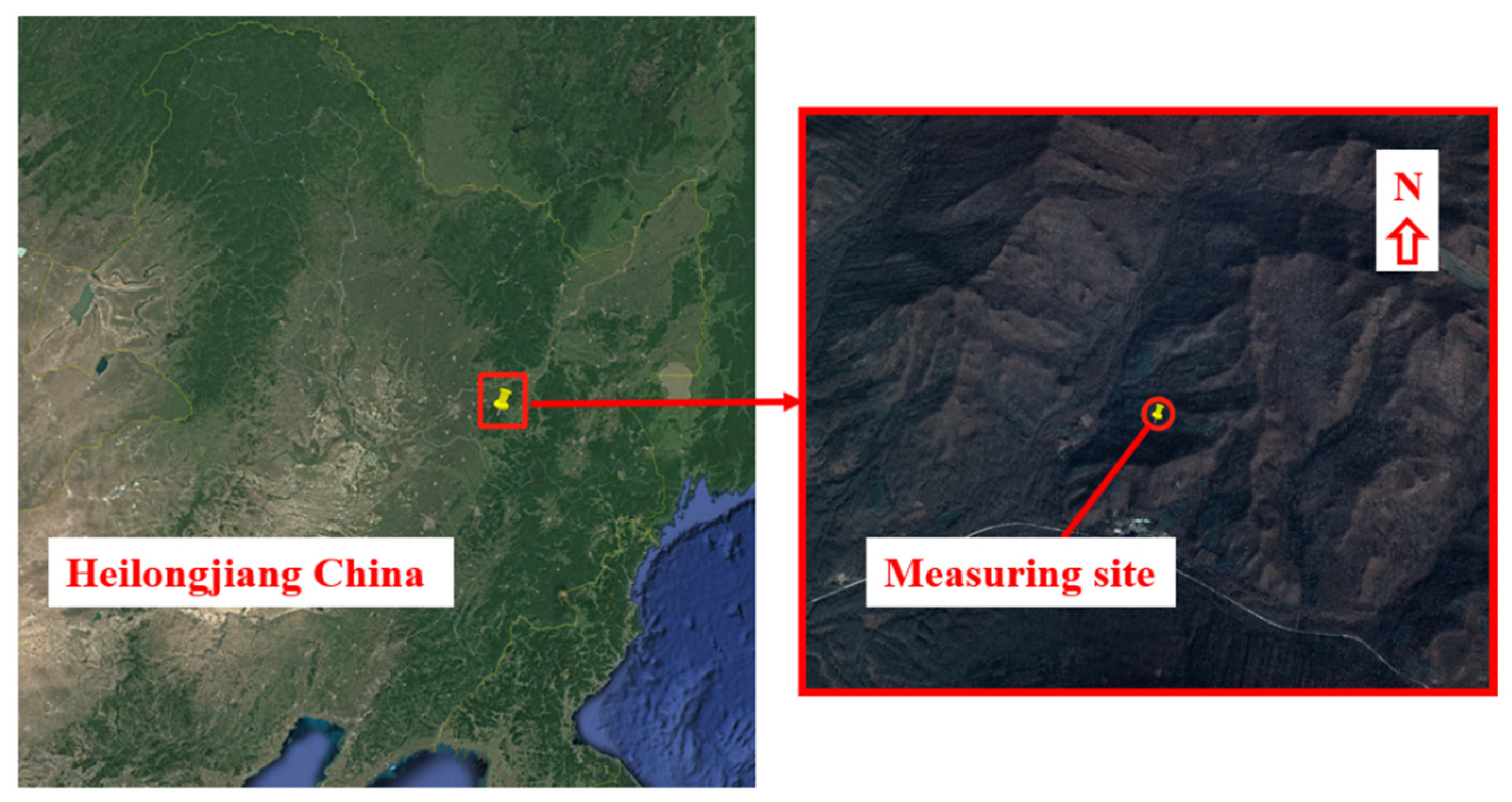
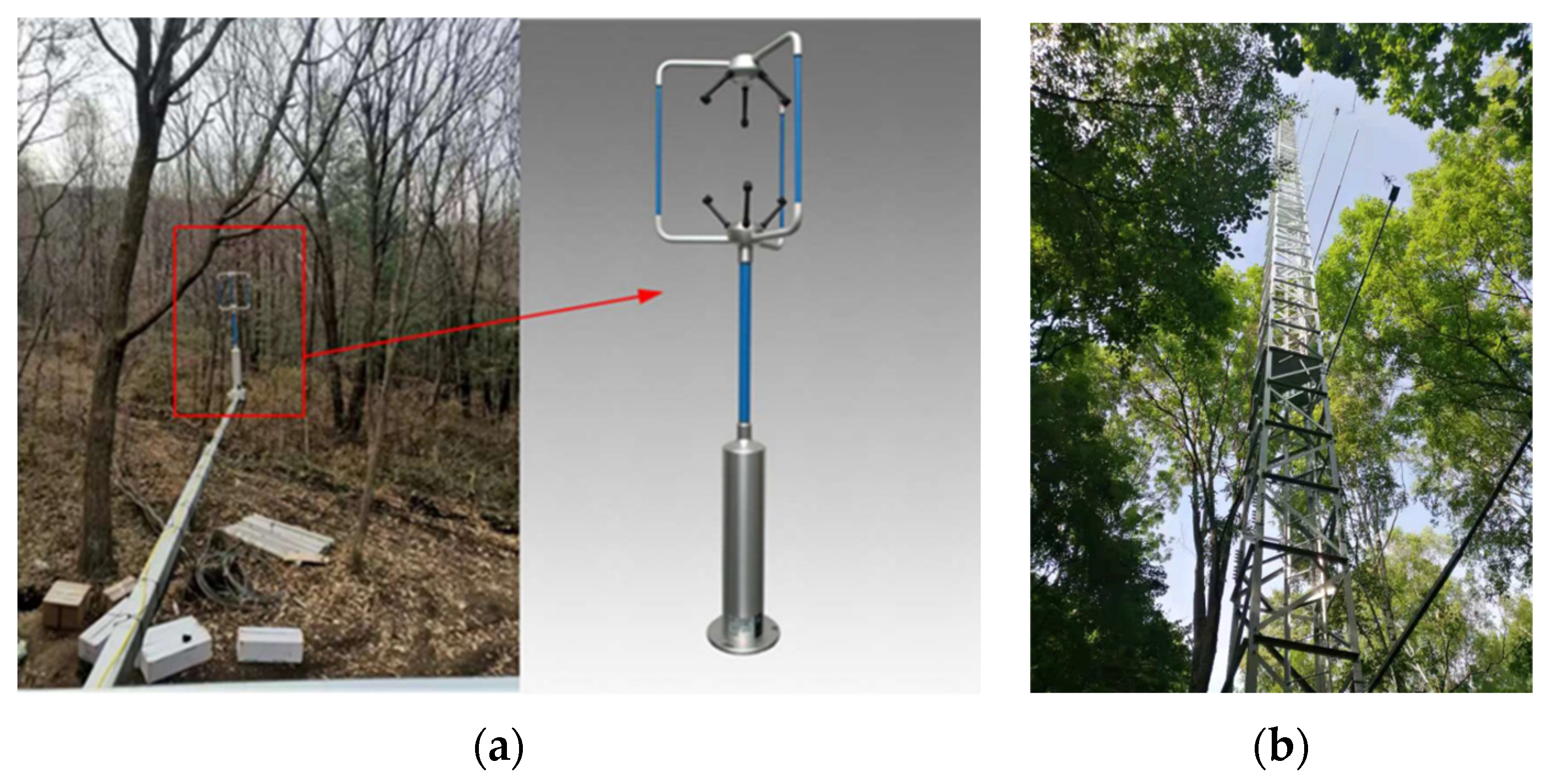
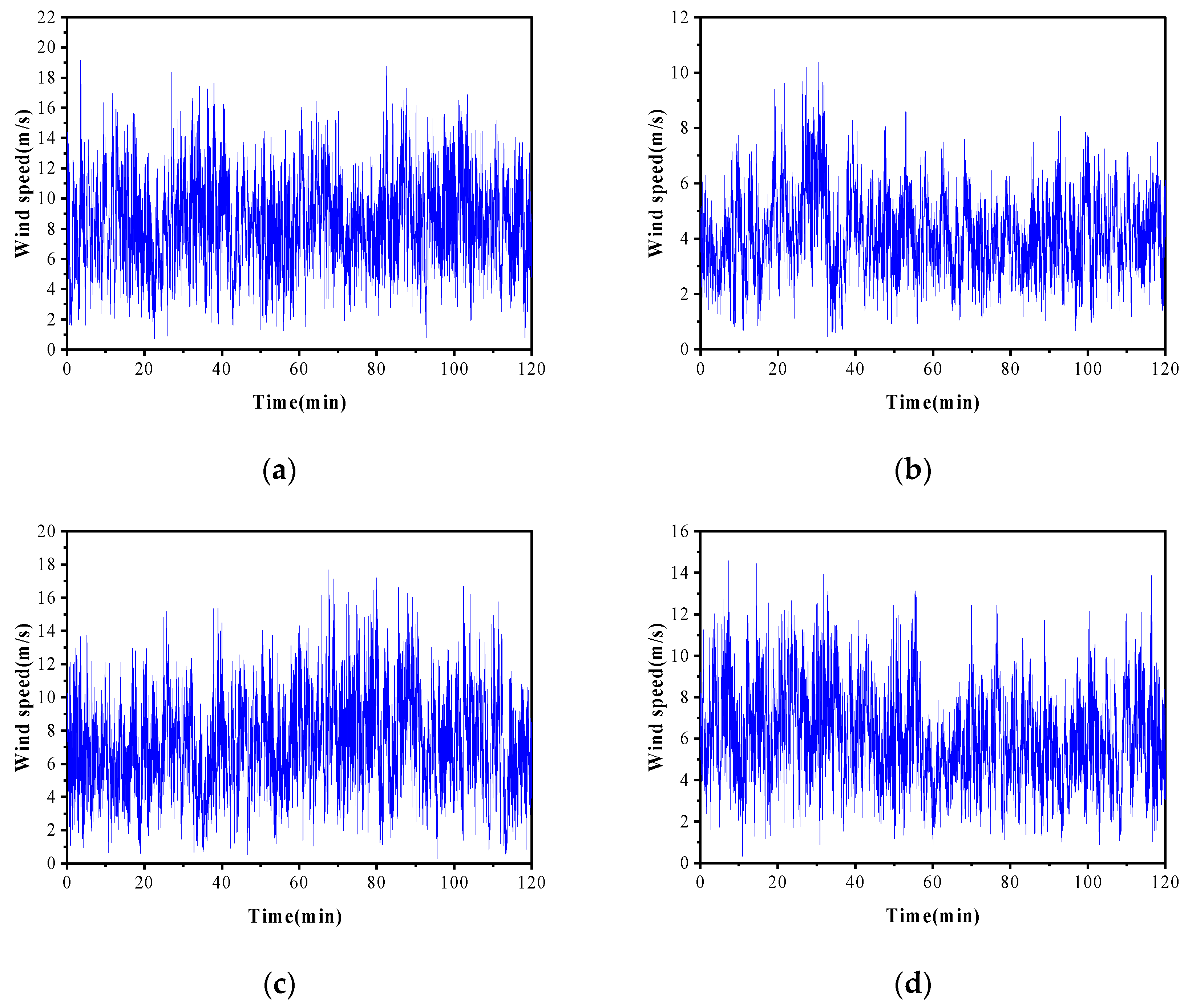
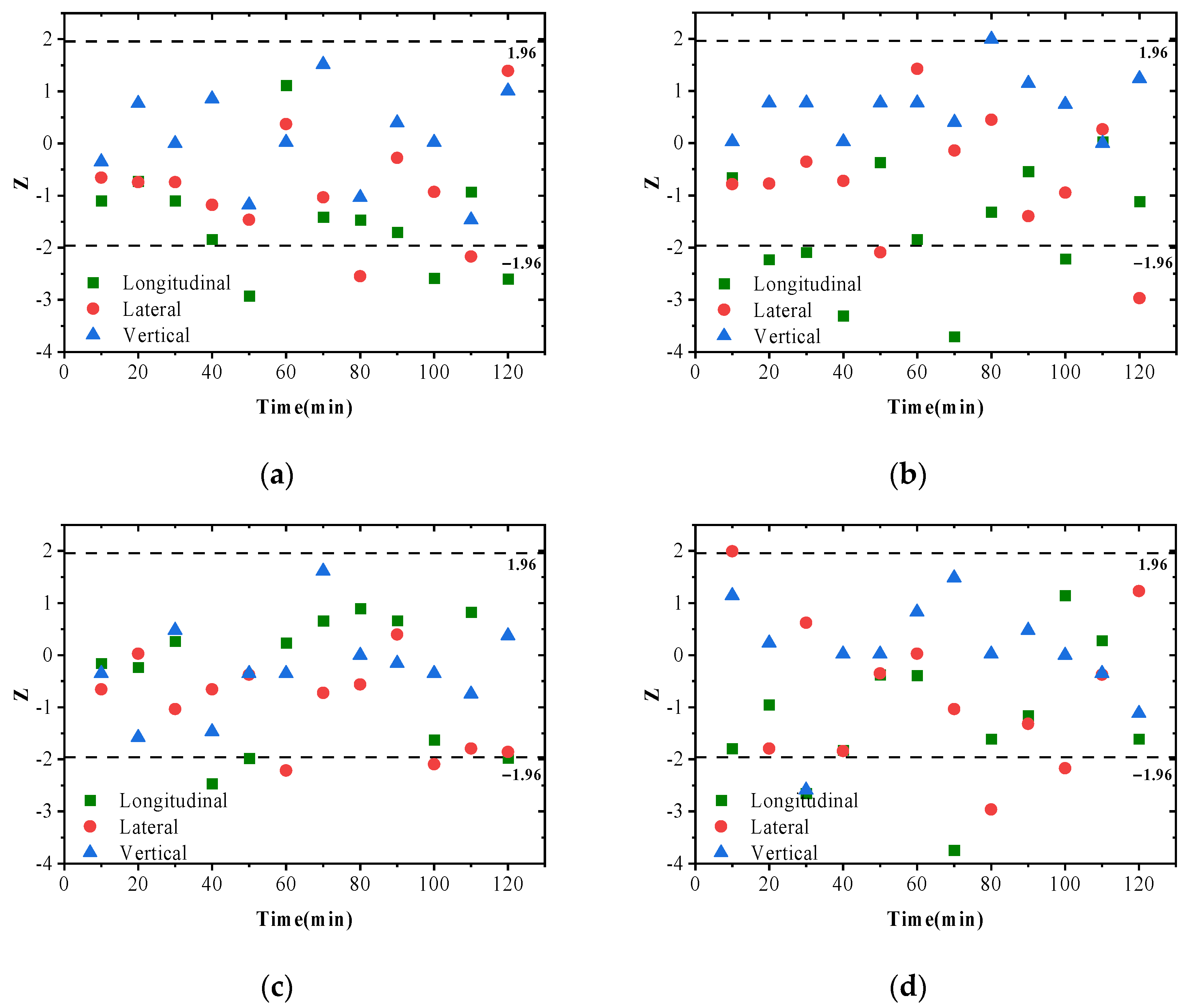





















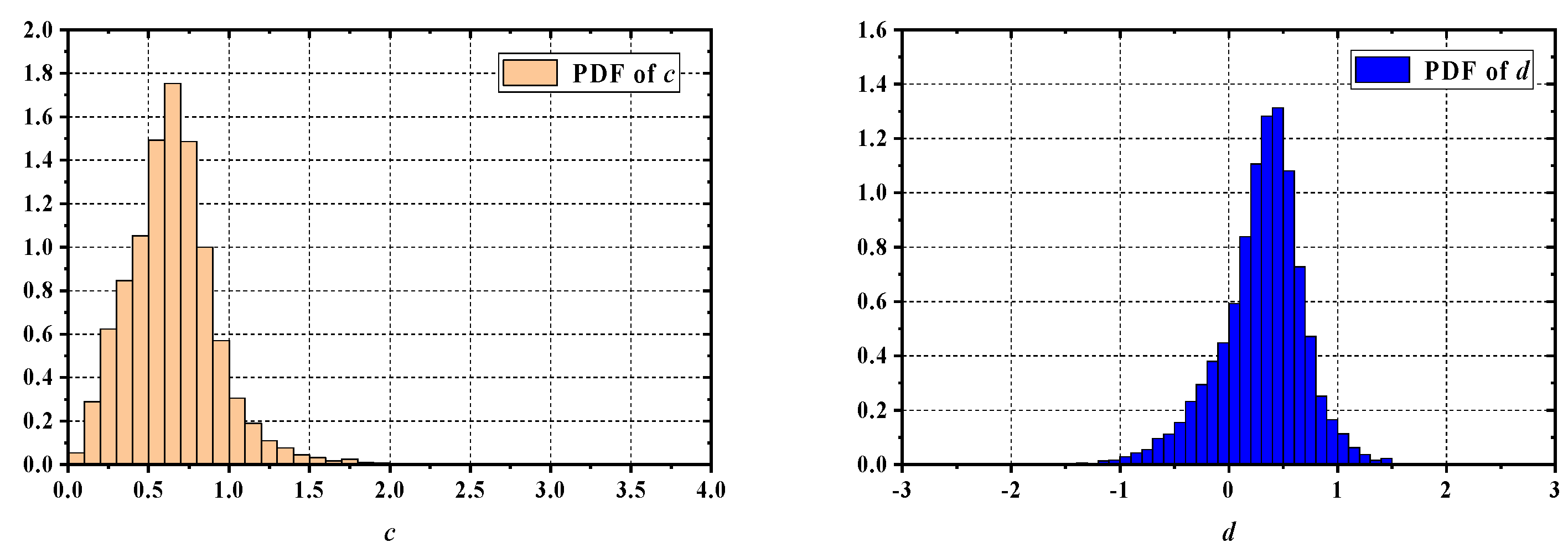
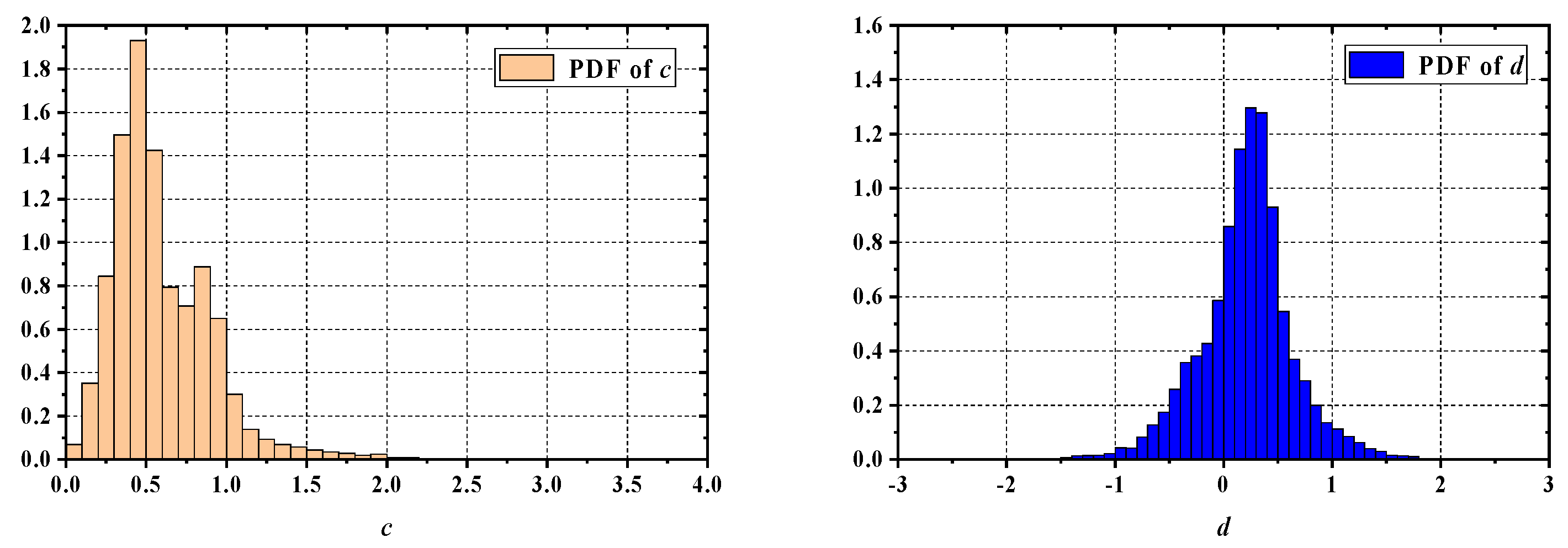
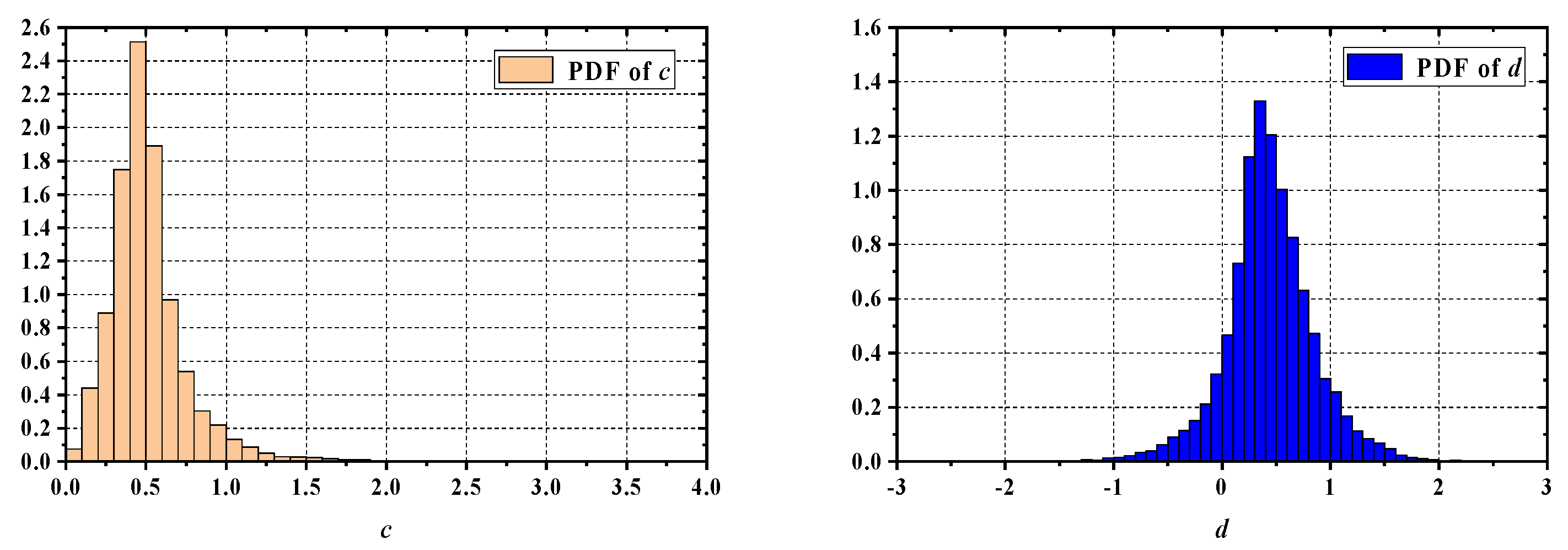
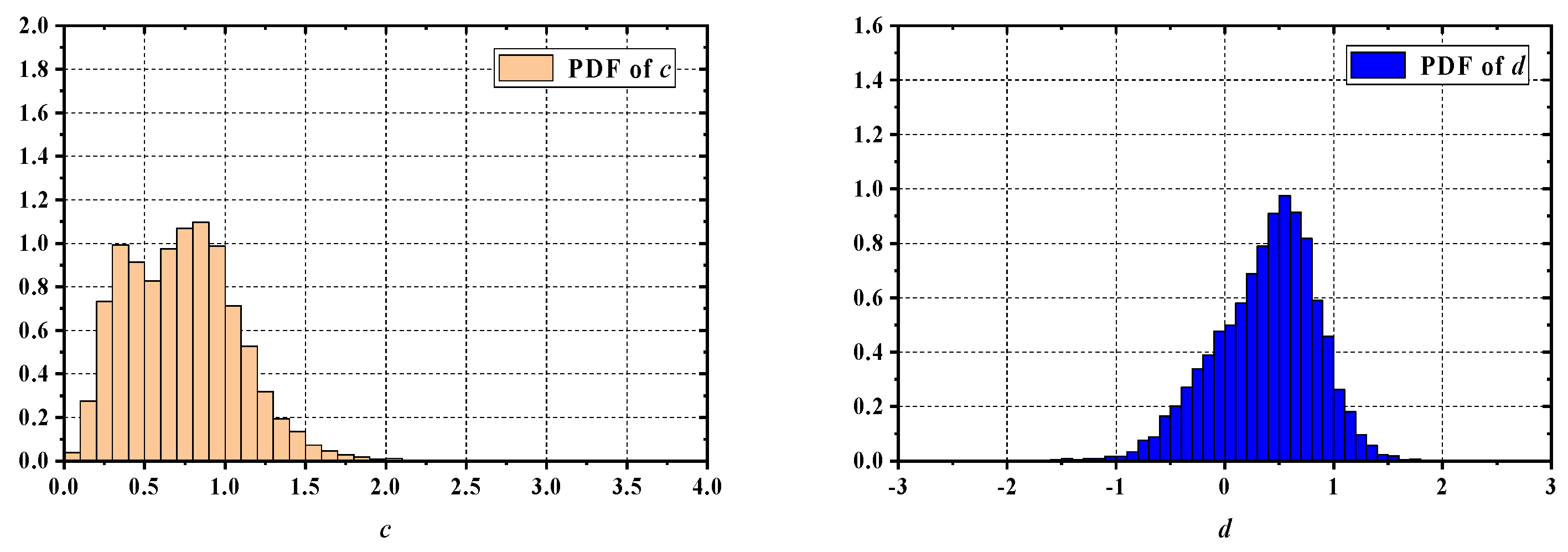
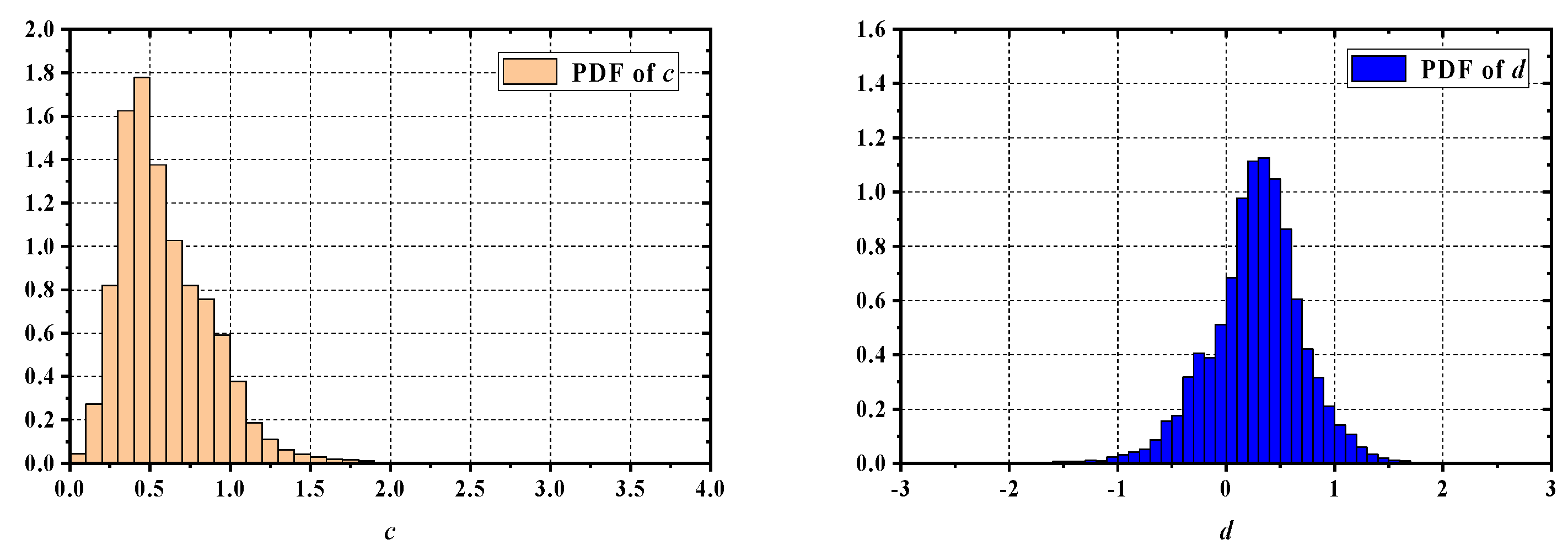
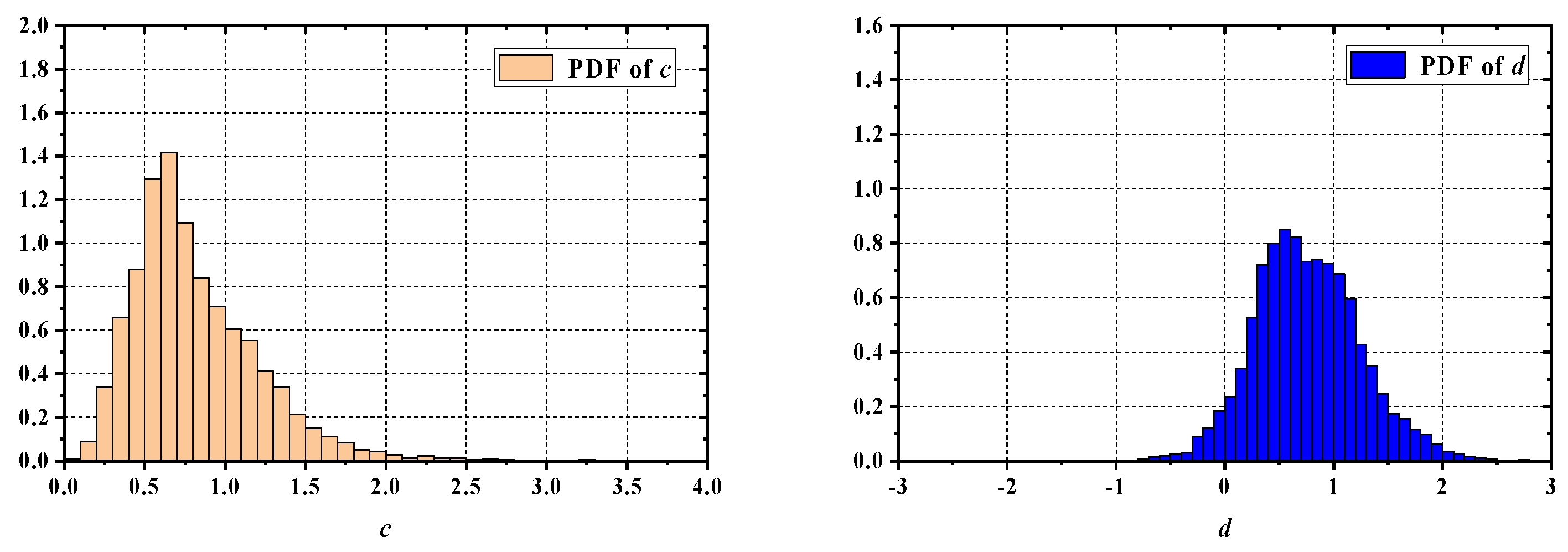

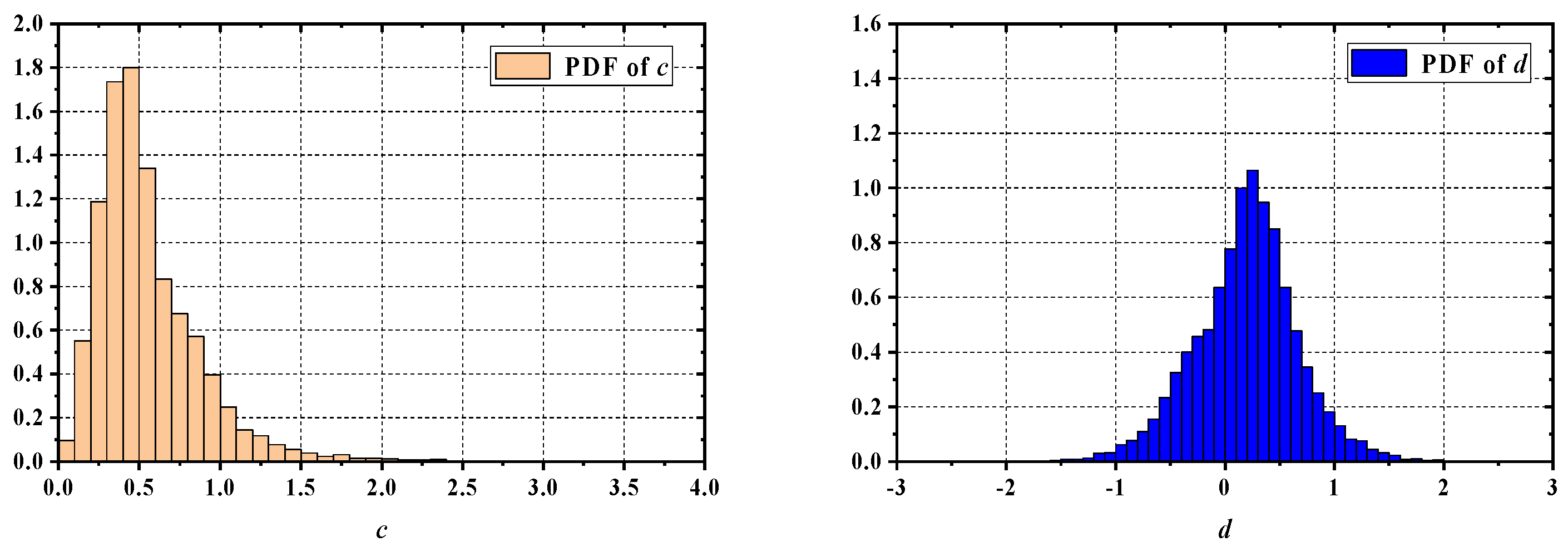


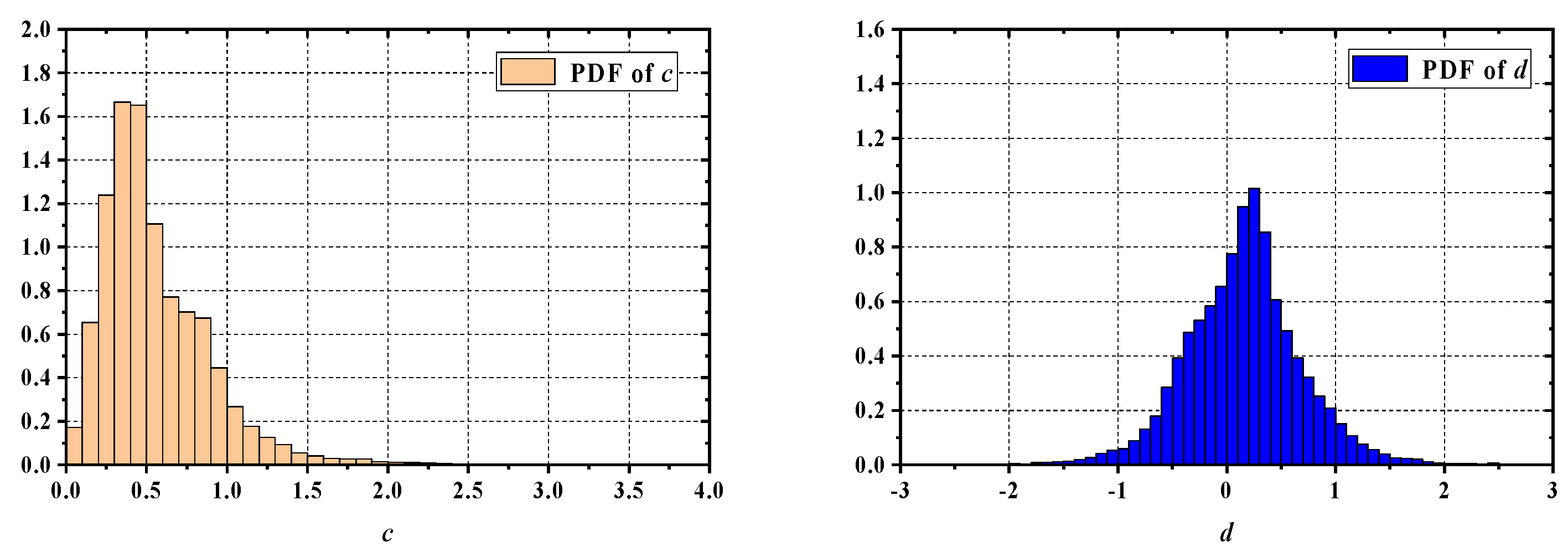



































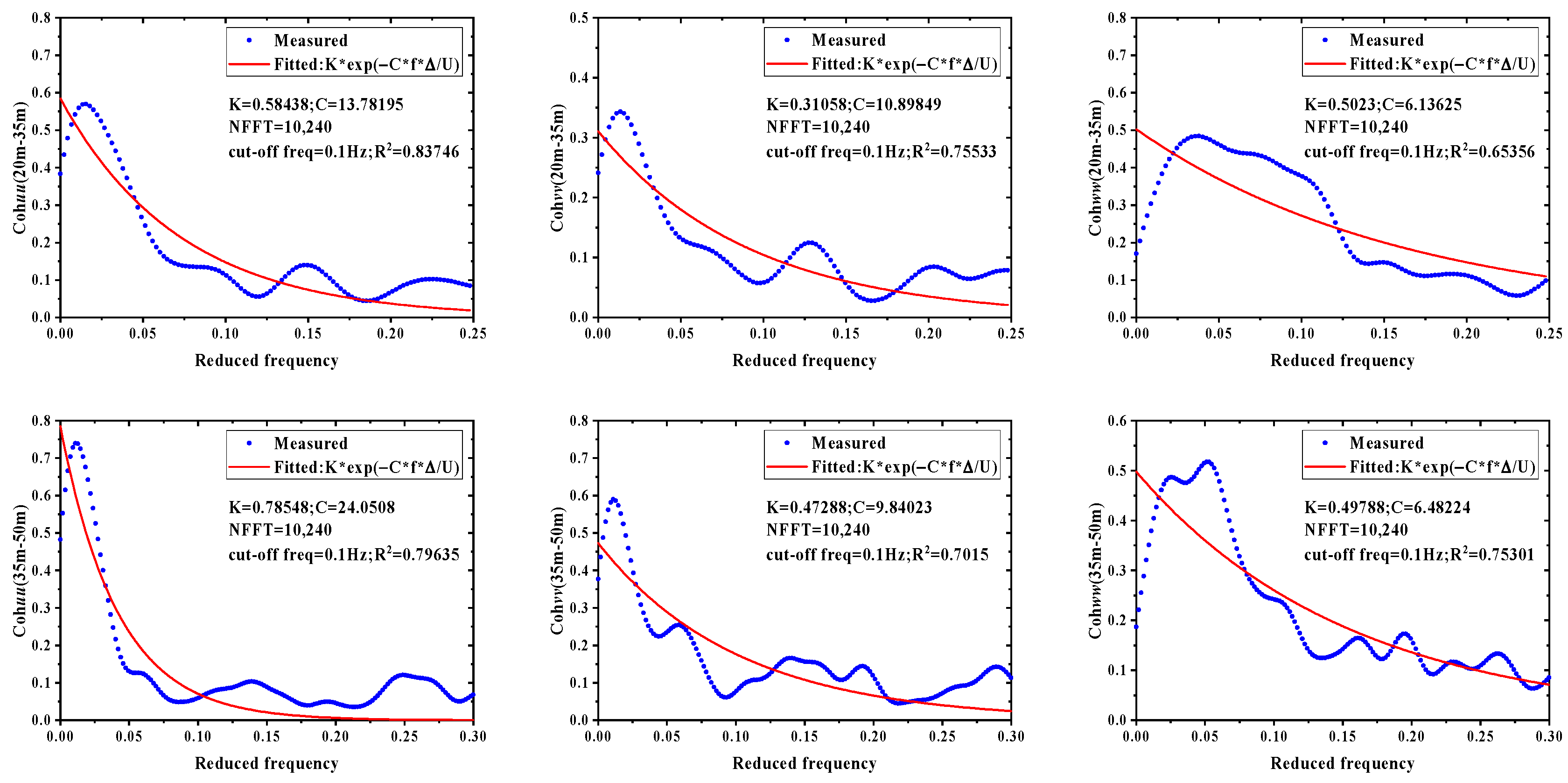

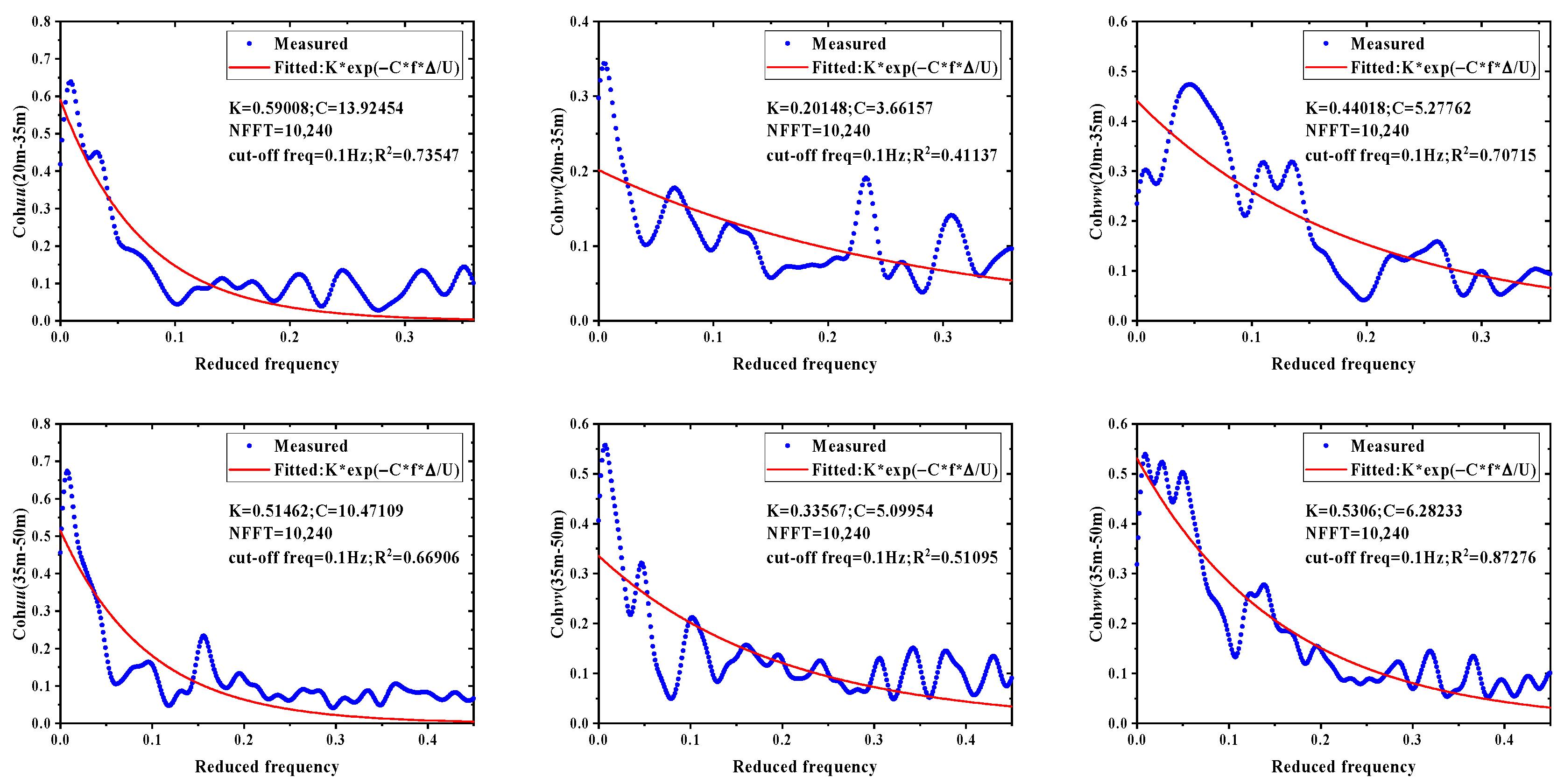


| Season | Direction | Stationary | Non-Stationary |
|---|---|---|---|
| Spring | Longitudinal | 75% | 25% |
| Lateral | 83.3% | 16.7% | |
| Vertical | 100% | 0% | |
| Summer | Longitudinal | 58.3% | 41.7% |
| Lateral Vertical | 83.3% 91.7% | 16.7% 8.3% | |
| Autumn | Longitudinal | 75% | 25% |
| Lateral | 83.3% | 16.7% | |
| Vertical | 100% | 0% | |
| Winter | Longitudinal | 83.3% | 16.7% |
| Lateral Vertical | 75% 91.7% | 25% 8.3% |
| Height | Season | Iu:Iv:Iw |
|---|---|---|
| 20 m | Spring | 1:0.998:0.75 |
| Summer | 1:0.927:0.909 | |
| Autumn | 1:0.986:0.833 | |
| Winter | 1:1.038:0.748 | |
| 35 m | Spring | 1:1.07:0.6 71 |
| Summer | 1:1.043:0.686 | |
| Autumn | 1:1.033:0.67 | |
| Winter | 1:1.115:0.644 | |
| 50 m | Spring | 1:1.099:0.674 |
| Summer | 1:1.035:0.693 | |
| Autumn | 1:1.056:0.671 | |
| Winter | 1:1.165:0.639 |
Disclaimer/Publisher’s Note: The statements, opinions and data contained in all publications are solely those of the individual author(s) and contributor(s) and not of MDPI and/or the editor(s). MDPI and/or the editor(s) disclaim responsibility for any injury to people or property resulting from any ideas, methods, instructions or products referred to in the content. |
© 2023 by the authors. Licensee MDPI, Basel, Switzerland. This article is an open access article distributed under the terms and conditions of the Creative Commons Attribution (CC BY) license (https://creativecommons.org/licenses/by/4.0/).
Share and Cite
Yue, H.; Zhao, Y.; Xin, D.; Xu, G. Seasons Effects of Field Measurement of Near-Ground Wind Characteristics in a Complex Terrain Forested Region. Sustainability 2023, 15, 10806. https://doi.org/10.3390/su151410806
Yue H, Zhao Y, Xin D, Xu G. Seasons Effects of Field Measurement of Near-Ground Wind Characteristics in a Complex Terrain Forested Region. Sustainability. 2023; 15(14):10806. https://doi.org/10.3390/su151410806
Chicago/Turabian StyleYue, Hao, Yagebai Zhao, Dabo Xin, and Gaowa Xu. 2023. "Seasons Effects of Field Measurement of Near-Ground Wind Characteristics in a Complex Terrain Forested Region" Sustainability 15, no. 14: 10806. https://doi.org/10.3390/su151410806
APA StyleYue, H., Zhao, Y., Xin, D., & Xu, G. (2023). Seasons Effects of Field Measurement of Near-Ground Wind Characteristics in a Complex Terrain Forested Region. Sustainability, 15(14), 10806. https://doi.org/10.3390/su151410806





